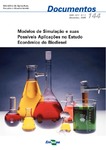Por favor, use este identificador para citar o enlazar este ítem:
http://www.infoteca.cnptia.embrapa.br/infoteca/handle/doc/570355Registro completo de metadatos
| Campo DC | Valor | Lengua/Idioma |
|---|---|---|
| dc.contributor.author | KINPARA, D. I. | pt_BR |
| dc.date.accessioned | 2011-07-08T11:53:13Z | - |
| dc.date.available | 2011-07-08T11:53:13Z | - |
| dc.date.created | 2008-01-10 | pt_BR |
| dc.date.issued | 2005 | pt_BR |
| dc.identifier.citation | Planaltina, DF: Embrapa Cerrados, 2005. | pt_BR |
| dc.identifier.uri | http://www.infoteca.cnptia.embrapa.br/infoteca/handle/doc/570355 | pt_BR |
| dc.description | This paper introduces the system simulation technique and looks for potential application in the biodiesel agribusiness. The simulation basics are presented. It's described the components of a simulation model, the models classification and the model construction process. Some uses in decision making and agricultural problems are shown. The decision making models search for possibilities while scientific models search for probabilities. The agricultural models have a high degree of uncertainty. In biodiesel agribusiness, this uncertainty is represented by its nationwide market, the long-run decision making, high investments and deep and diffuse social and environmental impacts. A simulation model study would be able to quantify the tradeoffs between the vegetal oil sources and their raw material prices, initial investment, investment return, farmer income, crop productivity, social impact, environmental impact and production sustainability in different areas and markets. The answer to this question will help to build public investment policies in the Brazil's agroenergy and agriculture sectors, to help the farmer to plan his production, to define genetic improvement research lines, to build environmental indicators, to define a protocol of Clean Development Mechanism (CDM) projects evaluation, to support policultive and environmental diversity, to determine the antropic pressure and to integrate the different technical knowledge in one single model. This paper emphasizes the use of biodiesel as an alternative to generate electricity through stationary diesel engines in areas not supplied with power lines, mainly in the Northern and Northeastern part of Brazil. Due to the problem complexity, the simulation arises as an useful tool to support biodiesel studies. | pt_BR |
| dc.language.iso | por | pt_BR |
| dc.relation.ispartofseries | (Embrapa Cerrados. Documentos, 144). | pt_BR |
| dc.rights | openAccess | pt_BR |
| dc.subject | Modelagem matemática | pt_BR |
| dc.subject | Agroenergia | pt_BR |
| dc.subject | Simulation | pt_BR |
| dc.subject | Agroenergy | pt_BR |
| dc.title | Modelos de simulação e suas possíveis aplicações no estudo econômico do biodiesel. | pt_BR |
| dc.type | Folhetos | pt_BR |
| dc.date.updated | 2011-07-08T11:53:13Z | pt_BR |
| dc.subject.thesagro | Desenvolvimento Rural | pt_BR |
| dc.subject.thesagro | Simulação | pt_BR |
| dc.subject.nalthesaurus | biodiesel | pt_BR |
| dc.subject.nalthesaurus | mathematical models | pt_BR |
| dc.subject.nalthesaurus | rural development | pt_BR |
| dc.format.extent2 | 33 p. | pt_BR |
| riaa.ainfo.id | 570355 | pt_BR |
| riaa.ainfo.lastupdate | 2009-10-21 | pt_BR |
| Aparece en las colecciones: | Série Documentos (CPAC)  | |
Ficheros en este ítem:
| Fichero | Descripción | Tamaño | Formato | |
|---|---|---|---|---|
| doc144.pdf | 259.17 kB | Adobe PDF |  Visualizar/Abrir |









